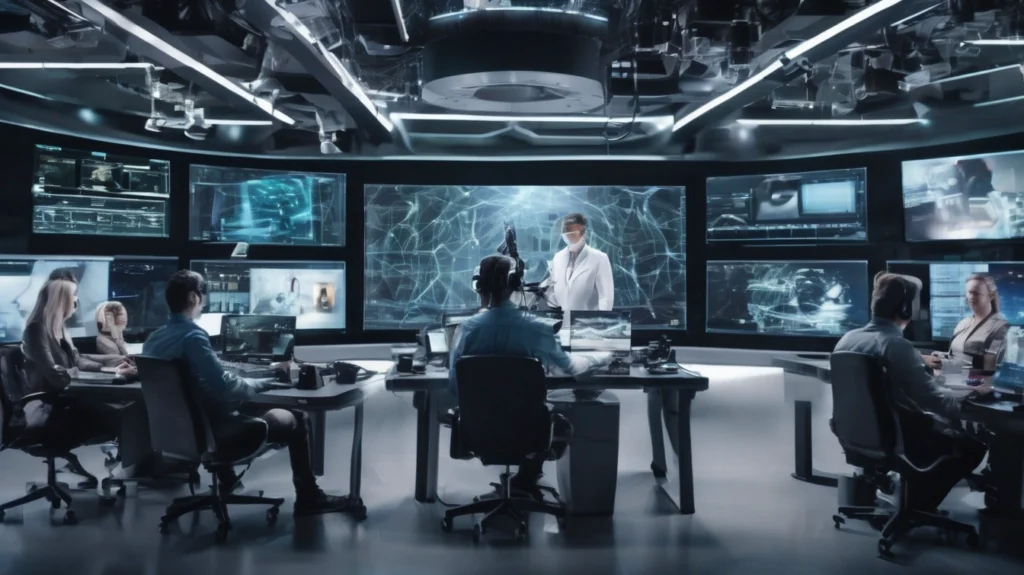

The audiovisual integration industry faces a critical challenge where technological capability meets human psychology. While the global Pro AV market rockets toward $422 billion by 2029 with AI adoption nearly doubling year-over-year, the real test isn’t implementing sophisticated algorithms—it’s convincing experienced professionals that artificial intelligence represents opportunity rather than obsolescence [1].
Senior AV professionals have built careers on hard-won expertise: acoustic modeling nuances, signal flow intricacies, and system interactions that make or break installations. When AI generates system designs in seconds that previously required hours of expert analysis, these professionals naturally question their value [2].
This goes beyond job security to professional identity. A senior engineer with decades of experience visualizing complex systems may feel reduced to a technician following automated instructions. Add age demographics and the potential loss of institutional knowledge, and the stakes become clear [3].
Unlike traditional AV equipment, where the technology is comprehensible, AI operates as a “black box,” creating discomfort among professionals who need to understand their tools. Many AV companies have built cultures around craftsmanship and problem-solving that emphasize human skill—introducing AI can feel like rejecting these core values.
Let’s be direct: your team won’t welcome AI initially. They’ll worry about job security and assume it’s another doomed corporate initiative. But we’ve seen the transformation that follows when handled correctly.
Position AI as an amplifier, not a replacement. A 55-year-old senior systems designer was convinced his three decades of experience had become worthless. Six months later? “It’s like I got 30 years younger. I’m designing systems I could only dream about because I’m not wasting time on calculations” [4].
Start with tasks everyone hates—mind-numbing cable schedules, endless submittal revisions, repetitive compliance checking. When AI eliminates tedious work, resistance melts into curiosity.
Then identify your most influential skeptic and give them a low-risk project where AI makes them shine. When they complete two weeks of work in three days and make it to their kid’s soccer game, they become your most powerful advocate.
Effective AI adoption requires a comprehensive strategy addressing both technical and human transformation. Communication must articulate a clear vision positioning AI as enhancing rather than replacing human capabilities. Acknowledge legitimate concerns while providing concrete examples of new opportunities [5].
Training programs should build confidence gradually, beginning with simple applications providing immediate value. Rather than overwhelming team members with comprehensive AI training, focus on how AI enhances existing skills [6].
Mentorship programs pairing AI-curious members with skeptical colleagues leverage existing trust to facilitate knowledge transfer. Recognition systems should reward successful AI integration and peer support, reinforcing desired behaviors.
Most AV professionals don’t need to understand neural networks—they need to know how AI tools solve specific problems. Start with practical applications: automating cable scheduling, generating documentation, optimizing equipment placement [7].
Hands-on experience beats theoretical training. Provide controlled environments for experimentation where mistakes don’t matter. Position AI as an extension of familiar tools, building on existing competencies rather than replacing them.
Progressive complexity allows comfortable skill development. Begin simple, introduce sophistication gradually, and leverage peer learning to accelerate adoption while building team cohesion.
Target universal pain points for immediate impact. Cable scheduling—universally disliked, time-consuming, error-prone—becomes an ideal starting point. When AI generates accurate schedules in minutes instead of hours, value becomes undeniable [8].
Documentation generation and system optimization calculations showcase AI’s capabilities while demonstrating enhancement rather than replacement of expertise. Select applications providing clear, measurable improvements without disrupting workflows.
Define and communicate success metrics. Whether measuring time savings, accuracy improvements, or quality enhancements, concrete data builds the case for broader adoption.
Experienced professionals bring deep knowledge and client relationships but may harbor concerns about career relevance. Show them how AI amplifies expertise, enabling focus on strategic and creative work they find most fulfilling [9].
Younger professionals embrace technology readily but may lack practical experience. Position AI as accelerating their professional development by providing access to best practices that would otherwise take years to develop.
Mentorship programs pairing generations facilitate knowledge transfer while building cross-generational support. When senior members see AI helping them share expertise effectively, they often become strong advocates.
Track both quantitative operational improvements and qualitative team satisfaction. Productivity metrics demonstrate time savings and efficiency gains. Quality improvements in accuracy and consistency build confidence in automated processes [10].
Regular feedback identifies concerns and celebrates successes. Client satisfaction metrics connect AI adoption to business objectives—faster delivery, higher-quality designs, and responsive service demonstrate strategic value.
Evolve metrics as adoption progresses, from basic usage to optimization and innovation, maintaining focus on continuous improvement.
Successful AI adoption in AV organizations is fundamentally a human challenge. While AI provides powerful capabilities, value only materializes through teams that embrace these tools effectively.
Transformation demands patience and strategic thinking, balancing competitive urgency with the time required for cultural change. Focus on building trust through demonstration, creating opportunities for skeptics to experience benefits firsthand.
The investment in change management pays dividends beyond operational efficiency. Organizations successfully navigating AI adoption build innovation cultures, positioning them for long-term success. They retain valuable human assets while enhancing capabilities, creating difficult-to-replicate competitive advantages.
The future belongs to AV organizations effectively combining human expertise with AI capabilities. Companies mastering this integration will define the industry’s future, while those failing to address the human side of technological change will struggle in an AI-enhanced marketplace.
The path from AI-curious to AI-confident doesn’t require abandoning everything you know. It requires a supportive environment where you can ask “stupid” questions, share small wins, and learn from peers facing the same challenges. The conversation is just beginning, and your voice matters more than you might think. The good news is that there is a new community just for you.
Whether you’re taking your first steps into AI or ready to lead transformation initiatives, NEXXT provides the tools, connections, and support to ensure you’re not just keeping pace with change—you’re helping to shape what comes next. Join us in building the future of AV, where human expertise and AI capabilities combine to create possibilities we’re only beginning to imagine. Learn more at nexxtnow.com.
[1] AVIXA. “Pro AV Revenue Forecast to Reach $422 Billion by 2029.” August 21, 2024. https://www.avixa.org/about-us/press-room/2024/08/21/pro-av-revenue-forecast-to-reach–422-billion-by-2029–according-to-new-research-from-avixa
[2] Field Nation. “Addressing the audiovisual labor crisis: A strategic guide for AV professionals.” August 23, 2024. https://fieldnation.com/resources/addressing-the-av-labor-crisis
[3] Commercial Integrator. “2025 Pro AV Industry Predictions from Industry Leaders.” December 26, 2024. https://www.commercialintegrator.com/insights/2025-pro-av-industry-predictions/139136/
[4] Thomson Reuters. “Generative AI Adoption Nearly Doubles as Professional Services Reach Crossroads.” April 15, 2025. https://www.thomsonreuters.com/en/press-releases/2025/april/from-incubation-to-integration-generative-ai-adoption-nearly-doubles-as-professional-services-reach-crossroads
[5] McKinsey. “AI in the workplace: A report for 2025.” January 28, 2025. https://www.mckinsey.com/capabilities/mckinsey-digital/our-insights/superagency-in-the-workplace-empowering-people-to-unlock-ais-full-potential-at-work
[6] The CFO. “AI adoption surges to 72% among professionals.” June 3, 2025. https://the-cfo.io/2025/06/03/ai-adoption-surges-to-72-among-professionals/
[7] CCS Projects. “Top Trends In Audio-Visual Technology For 2025.” January 8, 2025. https://ccsprojects.com/top-trends-in-audio-visual-technology-for-2025/
[8] MASQ Lighting. “How AI is Transforming Audio-Visual Systems: Automation Acoustics.” April 11, 2025. https://www.masqlighting.com/how-ai-is-transforming-audio-visual-systems-automation-meets-acoustics
[9] AVIXA. “6 AV Trends to Look Out For in 2025.” January 7, 2025. https://www.avixa.org/pro-av-trends/articles/6-av-trends-to-look-out-for-in-2025
[10] Audio Video Group. “AI in AV: How Artificial Intelligence is Revolutionizing Commercial Audio and Video Systems.” July 23, 2025. https://audiovideogroup.com/ai-in-av-how-artificial-intelligence-is-revolutionizing-commercial-audio-and-video-systems/
Share this post: